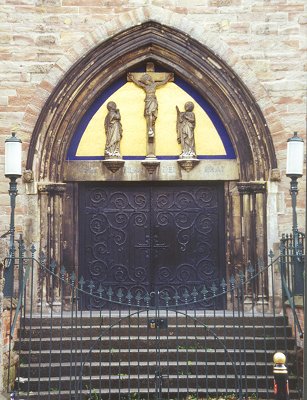Conclusions
There is little doubt that the period 1828-67 saw considerable
development in the Roman Catholic community in Wolverhampton. The
dramatic growth in the number of Catholics in the town was largely
responsible for this development. Only one in every 33 Wulfrunians was a
Roman Catholic at the beginning of the period whilst, at its close, the
figure stood at one in six.. Other evidence of growth can be seen from
the programme of church building, with three places of worship being
built and opened during the thirty-nine years in question. At the same
time, several new schools were opened: St Mary's in Blakenhall, St
Patrick's and St George's in Little's Lane, and SS Mary & John's on
Snowhill.
The factors responsible for this increase both in human and material
terms are of considerable importance. There is some evidence of a
"Second Spring" with many conversions in the 1830s, though it is obvious
that the most significant factor was the arrival of thousands of Irish
during the famine years. The mid-century estimate of 6,000 Irish in
Wolverhampton is proof of the extent of their penetration, and it is
clear that, from this point onwards, their presence was probably the
greatest determinant in the development of Catholicity in the town.
When SS Peter & Paul's chapel was opened in 1828, it was possible for
all the Roman Catholics in the town to be accommodated at one service.
By 1867, however, the three churches in Wolverhampton had only enough
room to seat 20 per cent of the town's adherents. As in many other
industrial towns, therefore, the influx of Irish families put a great
deal of strain on the resources of the Roman Catholic Church in
Wolverhampton. In this town, on the other hand, the immigrants were
prepared to help remedy this situation by building a church of their
own.
|
 The main doorway to Ss
Mary and John's Church,
Snow Hill.
The main doorway to Ss
Mary and John's Church,
Snow Hill. |
Apart from greatly increasing the size of the Roman
Catholic population of Wolverhampton in a relatively short period,
the Irish were also responsible for changing the social balance of
the community. In the late 1820s, the Catholics of Wolverhampton
were a typical cross-section of the town's society as a whole, but
four decades later, the domination of the group by unskilled Irish
labourers and their families meant that Catholicism was seen by many
Protestants as catering mainly for those of the lower social order.
This feeling was reinforced by the fact that the Catholic schools
were principally concerned with the education of the poorer children
in the town.
The strongest opponents of Roman Catholicism, of whom
there were several amongst the Evangelical ministers of the various
Protestant denominations, regarded a Catholic community dominated by
the Irish as a foreign, violent and unwelcome body. |
The attacks from outside forces which occurred throughout the period
were never sustained. Just as E. R. Norman describes in a wider context,
anti-Catholic agitation in Wolverhampton flared up as the result of
particular national events or with the arrival of certain notorious
Protestant orators. While it may have been expected that fierce
criticism from others would have united the Catholic body, this was
often far from the case. Again, the Wolverhampton situation reflects the
national struggle between clergy and laity for domination of the
Catholic community. In John Hawkesford the Roman Catholic clergy had a
formidable opponent, though it is not possible to conclude by 1867
whether this power struggle had been resolved. This area could be
developed by future study. The tension between English Catholics and
their Irish counterparts, as outlined by O'Tuathaig, is borne out by
events in Wolverhampton. The building of St Patrick's was partly a
consequence of the Anglo-Irish tensions within the Wolverhampton
Catholic body, though there is little other evidence in the local press
or Archdiocese Archives. It would be interesting to look at the period
after 1867 to discover whether the Irish in Wolverhampton had become
more integrated into society as a whole and within the town's Catholic
community in particular.
Future research might also show if any other orators followed in the
train of Gavazzi, de Camin, and Murphy, and whether the Evangelical
Protestants softened in their opposition to Roman Catholicism. Was the
reaction to the announcement of Papal infallibility in 1870 similar to
that which greeted the Restoration of the Catholic hierarchy two decades
earlier, or did it pass off in Wolverhampton with muted protest?
The provision of education was considered by the Catholic Church to be
of paramount importance and, in Wolverhampton, despite the limited
finance and rapidly expanding demand, some progress was made. The
attitude of Catholics in Wolverhampton to the 1870 Education Act is
another topic for future examination which would reveal how the
principle of State involvement was viewed locally.
The development of the Catholic community in Wolverhampton had been
shaped both by outside forces and by various internal pressures. It was,
however, the latter which was of greater significance, since the degree
and nature of the growth of the Catholic body produced the dynamic
momentum which became the generating force behind this development.
|

